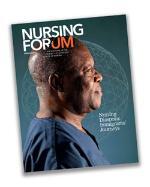5 Tips for Precepting Students
May 01, 2019 Libby ZayPreceptors help prepare students for success in their careers, bridging the gap between the classroom and the ‘real world.’
They serve as role models, educators, and confidants to their mentees. It may sound like a daunting task, but it doesn’t have to be. These tips from nurses who have precepted UMSON students can help you make precepting the best experience possible — for both of you.
1. Know your role.
Examining your own purpose and motivation for precepting is key. Similarly, you also should evaluate your strengths and potential challenges. This will allow you to promote a safe and respectful environment where you can foster collaborative relationships and maintain open lines of communication with your mentee.
Tom Trobiano, MSN, MAPC, CRNP, FNP-C
Cardiothoracic Transplant and Advanced Heart Failure Program Manager, University of Maryland Medical Center
2. Meet students where they are.
On your first day with a new student, have a conversation regarding goals for the experience and review course requirements. Ask them how they learn best — by using visuals, by listening, or by doing hands-on tasks. Take time to understand any intergenerational, cultural, or developmental challenges so that you can provide an ideal learning experience. Be flexible and adapt your precepting style to the learner.
Caitlin Donis, MS ’13, AG-ACNP, ACCNS-AG
Nurse Practitioner, University of Maryland Upper Chesapeake Medical Center
3. Start with the end in mind.
Establish and share expected outcomes. What should the student know and/or be able to do at the end of the precepting period? How will his or her competency be determined? What resources are needed? Armed with this information, preceptors can then assess the student’s learning needs and plan learning activities to ensure a safe, valuable experience.
Susan Bindon, DNP ’11, MS ’96, RN-BC, CNE, CNEcl
Assistant Professor and Director, Doctor of Nursing Practice Post-Master’s Option, University of Maryland School of Nursing
4. Create a safe space.
The environment in which we learn and work is essential. It is important to create an inviting space that is welcoming and allows for full engagement, learning, and communication. Without creating a safe space, you may lose the opportunity to develop a relationship and connect with the student.
Jennifer Brown, MS ’12, CRNP, AGPCNP-BC
Nurse Practitioner, Adult Emergency Department, University of Maryland Medical Center
5. Get curious.
Curiosity and a desire to understand students’ perspectives promote mutual respect and create an environment where students feel comfortable asking questions. Approaching students with a sense of inquiry allows for meaningful, focused communication that more accurately identifies performance gaps and results in improvement. When in doubt, lean in and get curious!
Michelle Moulton, MS ’09, RN, PCCN-K, CHSE
Clinical Instructor, University of Maryland School of Nursing
Current and Future Preceptors:
Receive up to 11 continuing education credits through our APRN Preceptor Development program at no cost to you, thanks to a Nurse Support Program II grant. The program includes seven online modules and one in-person simulation session.
Illustration by Francesco Ciccolella
 This article first appeared in the Spring 2019 issue of Nursing For/um magazine.
This article first appeared in the Spring 2019 issue of Nursing For/um magazine.